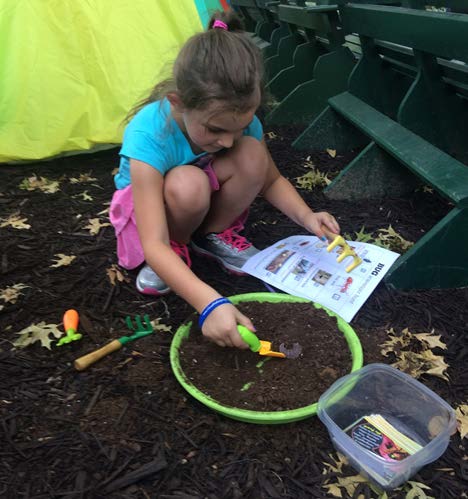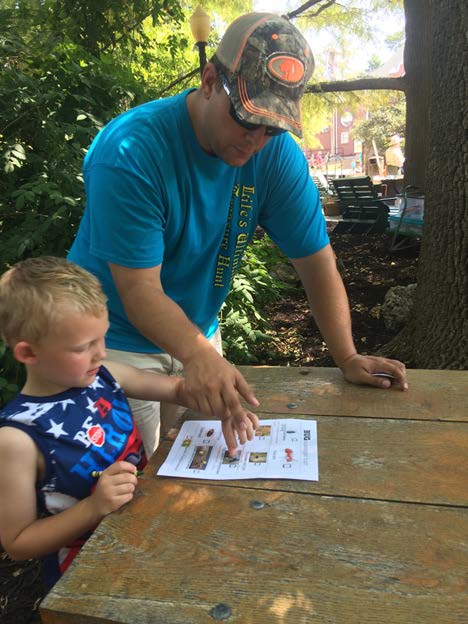AgEBB-MU CAFNR Extension
Green Horizons
Volume 22, Number 3
Fall 2018
Outreach & Engagement
Let's Go on a Bug Hunt!
By Sarah Phipps| Missouri Department of Agriculture
 |
"We be Grubbin" station, sifting through soil, a plastic Japanese beetle grub is found. Credit Sarah Phipps, MDA. |
The day is warming fast; the Missouri State Fair is in session and excitement is in the air. Various conservationists are mingling about, setting up their Show-Me State invasive pest booths. Thankfully, shaded by the large maple at the front and a large ash tree at the rear, we have some reprieve from the scorching sun. I scurry about, setting up scavenger hunt stations as a robust cicada killer wasp persistently searches for her burrow.
Families begin to filter from campsites into the dappled shade. I ask kids as they enter the picnic area, "Do you know what an invasive bug is?" Some of the older children give thorough answers, explaining that they're insects who aren't from here; they take over the environment and can kill trees.
The bug hunt is on! Kids grab scavenger hunt checklists and magnifying glasses and begin to search around the heavily mulched picnic table area for 10 different stations. They search for a long horned beetle on a log, grubs in the dirt, ants in plants like fire ants moving from southern states by hitchhiking in soil, d-shaped exit holes where the invasive emerald ash borer chewed its way out of firewood and s-shaped galleries where beetles hungrily feed to reach adulthood. Informative cards at each station create a booklet on how to be a plant hero, while learning to protect the native natural environment from invasive species in our yards, roadsides, and natural communities.
What do these stations all have in common? They help to sharpen kids' observation skills while teaching them how invasive insects travel to our state, and how they can help. If they see a tree dying in their yard, hopefully they will now take a closer look; and if they find an invasive species, hopefully they will report it to Missouri Department of Agriculture or Missouri Department of Conservation.
During the day, I felt a great sense of camaraderie with conservationists manning multiple invasive pest booths. Our shared mission to increase awareness about all types of invasive species from A-Z, including invasive ants, plants and zebra mussels, filled me with a sense of solidarity. Meanwhile, seeing an older brother trick his little sister by lifting up the gag cookie with the cockroach dangling below by monofilament brought a lighter side to this heavy topic; fun and learning about the natural environment all in one. After the scavenger hunt is completed, one mom points out a hole she finds on the maple tree, albeit from a native insect. It was great to see the learning being applied outside our classroom.
 |
A father helps his son find insects on the scavenger hunt. Credit Sarah Phipps, MDA. |
As I pack up at the end of the long day, I think about the trees. The trees that made the day tolerable from the unrelenting sun. The trees that already risk succumbing to invasive pests - the ash tree to the emerald ash borer and the maple tree to the Asian longhorned beetle. These trees need our protection.
When we explore nature, our minds are quieted and at peace. We see the forest but not the trees, the trees are just there standing guard, until they're not. Then they are missed for all the benefits they provide: shade, erosion control, habitat for animals, etc. Teaching kids when they are young to protect our natural environment is vital so they will grow up to become stewards of the land. Teaching kids to understand and love our natural environment is the only way we can sustain it. I hope you will join me in that mission.
